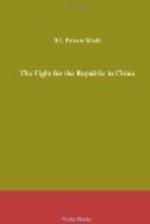Yang Tu for having publicly organized the said Society and Chu Chi-chien for having directly plotted by telegram are the principal offenders in the present flagrant case of sedition. As their crimes are obvious and the subject of abundant proof, we hereby ask the President to carry out at once the terms of the said mandate and publicly execute Yang Tu, Sun Yu-yun, Yen Fu, Liu Shih-pei, Li Hsieh-ho, Hu Ying, Chu Chi-chien, Tuan Chih-kuei, Chow Tzu-chi, Liang Shih-yi, Chang Cheng-fang and Yuan Nai-kuan to the end that the whole nation may be pacified. Then, and not till then, will the world believe in the sincerity of the President, in his love for the country and his intention to abide by the law. All the troops and people here are in anger; and unless a substantial proof from the Central Authorities is forthcoming, guaranteeing the maintenance of the Republic, it will be impossible to suppress or pacify them. We await a reply within twenty-four hours.
(Signed) THE GOVERNORS OF YUNNAN PROVINCE.
[Illustration: General Feng Kuo-chang, President of the Republic.]
[Illustration: The Scholar Liang Chi-chao, sometime Minister of Justice, and the foremost “Brain” in China.]
It was evident from the beginning that pride prevented Yuan Shih-kai from retreating from the false position he had taken up. Under his instructions the State Department sent a stream of powerful telegraphic messages to Yunnan attempting to dissuade the Republican leaders from revolt. But the die had been cast and very gravely the standard of rebellion was raised in the capital city of Yunnan and the people exhorted to shed their blood. Everything pointed to the fact that this rising was to be very different from the abortive July outbreak of 1913. There was a soberness and a deliberation about it all which impressed close observers with a sense of the ominous end which was now in sight.
Still Peking remained purblind. During the month of January the splendour of the dream empire, which was already dissolving into thin air, filled the newspapers. It was reported that an Imperial Edict printed on Yellow Paper announcing the enthronement was ready for universal distribution: that twelve new Imperial Seals in jade or gold were being manufactured: that a golden chair and a magnificent State Coach in the style of Louis XV were almost ready. Homage to the portrait of Yuan Shih-kai by all officials throughout the country was soon to be ordered; sycophantic scholars were busily preparing a volume poetically entitled “The Golden Mirror of the Empire,” in which the virtues of the new sovereign were extolled in high-sounding language. A recondite significance, it was said, was to be given to the old ceremonial dress, which was to be revived, from the fact that every official would carry a Hu or Ivory Tablet to be held against the breast. The very mention of this was sufficient to make the local price of ivory




